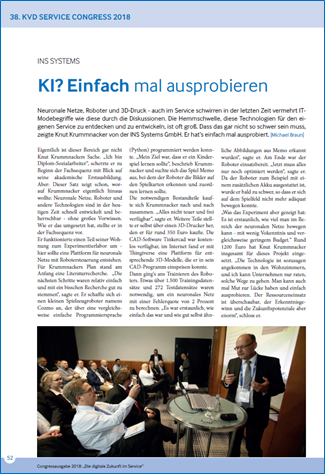14.01.2019 – Press review: „AI? Just do it yourself“ (Service Today 05/2018)
The current Service Today (member magazine of the German Customer Service Association KVD) includes a report by Michael Braun of the media house Waltrop that covers a lecture, which was held by Knut Krummnacker, Business Development Manager and authorized representative of INS Systems, on the 38th KVD Service Congress. We publish this article with the kind permission of the KVD.
AI? Just do it yourself…
Neural networks, robots, and 3D printing – fashionable IT terms such as these are increasingly buzzing through discussions in the service sector as well. The inhibition threshold in regards to discovering and developing these technologies for one’s own service is often great. However, Knut Krummnacker from INS Systems GmbH demonstrated quite well how easy this can be. He just did it.
Actually, this area of expertise is not really Knut Krummnacker’s thing. “I am a graduated social worker,” he joked about his initial academic education right at the beginning of his lecture. Nevertheless: This sentence alone already shows what Krummnacker wanted to convey: nowadays neural networks, robots, and other technologies are quickly developed and handled – without having much prior knowledge. During his lecture, he presented how he implemented this:
He transformed part of his apartment into an experimental laboratory – creating a platform for neural networks with robot control. Krummnacker’s plan started with a literature review. “The next steps were relatively easy and the research made the handling fairly simple,” he said. He acquired a small toy robot called Cozmo, which could be programmed using a relatively simple programming language (Python). “My goal was that he should learn a children’s game,” said Krummnacker, and picked the game memo, for which the robot would have had to learn to recognize the images on the playing cards and identify them. Krummnacker bought the necessary components gradually. “None of it was expensive and everything freely available,” he said. Furthermore, he utilized a 3D printer, which he bought for around 350 euros, to make further parts himself. The Tinkercad CAD software was available free of charge, and with Thingiverse he found a platform for corresponding 3D models, which he was able to use with his CAD program.
Then, it was time to train the robot. A bit over 1,500 training records and 272 test records were needed to calculate a neural network with a 2 percent error rate. “It was amazing how easy that was, and how well even similar images from Memo were recognized,” he said. In the end, the robot was ready for use. “The only thing left to do is to optimize everything,” he said. For example, since the robot is equipped with an extra battery, it became too heavy for it to be able to move adequately on the field.
“What the experiment clearly showed: It’s amazing how much you can achieve in the field of neural networks – with little prior knowledge and comparatively low budget.” Knut Krummnacker spent around 1,200 euros on this project in total. “As it were, the technology has arrived people’s living rooms, and I can only advise companies to follow such routes. Sometimes you just have to brave the gap and just try it out. The amount of resources needed is manageable, and the gain in regards to knowledge and future potential are enormous,” he concluded.





